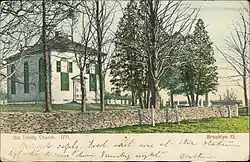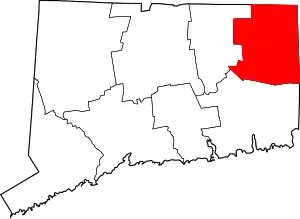Brooklyn, Connecticut
Brooklyn is a town in Windham County, Connecticut, United States. The population was 8,210 at the 2010 census. The town center village is listed by the U.S. Census Bureau as a census-designated place. The district of East Brooklyn is also listed as a separate census-designated place.
Brooklyn, Connecticut | |
|---|---|
 Seal | |
 Location in Windham County and the state of Connecticut. | |
| Coordinates: 41°47′17″N 71°56′59″W | |
| Country | United States |
| State | Connecticut |
| NECTA | Danielson |
| Region | Northeastern Connecticut |
| Incorporated | 1786 |
| Government | |
| • Type | Selectman-town meeting |
| • First selectman | Richard A. Ives (D) |
| • State Senator | Mae Flexer (D-29th District) |
| • State Rep. | Pat Boyd (D-50th District) |
| Area | |
| • Total | 29.1 sq mi (75.4 km2) |
| • Land | 29.0 sq mi (75.0 km2) |
| • Water | 0.2 sq mi (0.4 km2) |
| Elevation | 210 ft (64 m) |
| Population (2010) | |
| • Total | 8,210 |
| • Estimate (2014) | 8,254 |
| • Density | 266/sq mi (103/km2) |
| Time zone | UTC-5 (EST) |
| • Summer (DST) | UTC-4 (EDT) |
| ZIP code | 06234, 06239 |
| Area code(s) | 860 |
| FIPS code | 09-09190 |
| GNIS feature ID | 0213400 |
| Website | www |


Geography
According to the United States Census Bureau, the town has a total area of 29.1 square miles (75 km2), of which, 29.0 square miles (75 km2) of it is land and 0.2 square miles (0.52 km2) of it (0.58%) is water.
History
Settled in the late 17th century and incorporated as its own town in 1786, Brooklyn is now one of the fastest growing towns in Windham County. It is named for the Quinebaug River, or Brook Line, which forms its eastern boundary. Originally land of the Wabaquasset, Brooklyn incorporated as a town separate from Canterbury and Pomfret in May 1786. It is home to the Brooklyn Fair, America's oldest continuously operating agricultural fair, as well as the Brooklyn Correctional Institution, a state-run medium security prison.
Brooklyn held the 1833 trial of Prudence Crandall, a schoolteacher charged with the crime of educating black female students in nearby Canterbury.
Brooklyn is the final resting place of Revolutionary War General Israel Putnam. Though he was originally buried in an above ground tomb in Brooklyn's South Cemetery, his remains had to be moved due to excessive visitors. In 1888, a statue of Putnam mounted on a horse was erected, and his sarcophagus placed in the foundation. The statue stands slightly south of the town green, in front of the post office. Brooklyn is also home of the Middle School Bobcats and Elementary School Bears.
The town historical society operates the Brooklyn Historical Society Museum, which includes the Daniel Putnam Tyler Law Office.
Villages
- Allen Hill
- Barrett Hill
- Brooklyn Center
- Bush Hill
- East Brooklyn
- Stetson's Corners
- Tatnic Hill
- West Village
- West Wauregan
On the National Register of Historic Places
- Brooklyn Green Historic District — (added October 23, 1982)
- Bush Hill Historic District — (added March 10, 1987).[1]
- Putnam Farm — Spaulding Road (added April 11, 1982)
- Trinity Church — Church Street (added November 15, 1970)
- Unitarian Meetinghouse — (added December 9, 1972)
- Quinebaug Mill-Quebec Square Historic District — Roughly bounded by Quinebaug River, Quebec Square, Elm and South Main Streets (added August 29, 1985).
Education
Residents are served by the Brooklyn School District's Brooklyn Elementary School (K-4) and Brooklyn Middle School (5-8).
Many Brooklyn high school students attend Woodstock Academy; Woodstock was designated as one of Brooklyn's high schools since 1987.[2] Many Brooklyn high school students attend Killingly High School in Danielson.[3] Some students attend H.H. Ellis Technical High School, or the Norwich Free Academy.
Demographics
| Historical population | |||
|---|---|---|---|
| Census | Pop. | %± | |
| 1820 | 1,254 | — | |
| 1850 | 1,514 | — | |
| 1860 | 2,136 | 41.1% | |
| 1870 | 2,354 | 10.2% | |
| 1880 | 2,308 | −2.0% | |
| 1890 | 2,628 | 13.9% | |
| 1900 | 2,358 | −10.3% | |
| 1910 | 1,858 | −21.2% | |
| 1920 | 1,655 | −10.9% | |
| 1930 | 2,250 | 36.0% | |
| 1940 | 2,403 | 6.8% | |
| 1950 | 2,652 | 10.4% | |
| 1960 | 3,312 | 24.9% | |
| 1970 | 4,965 | 49.9% | |
| 1980 | 5,691 | 14.6% | |
| 1990 | 6,681 | 17.4% | |
| 2000 | 7,173 | 7.4% | |
| 2010 | 8,210 | 14.5% | |
| 2014 (est.) | 8,254 | [4] | 0.5% |
| U.S. Decennial Census[5] | |||
As of the census[6] of 2010, there were 8,244 people, 3,001 households, and 2,105 families residing in the town. There were 3,247 housing units at an average density of 92.4 per square mile. The racial makeup of the town was 92.7% White, 2.9% African American, 0.3% Native American, 1.1% Asian, 0% Pacific Islander, 1.8% from other races, and 1.2% from two or more races. Hispanic or Latino of any race were 4% of the population.
There were 3,001 households, out of which 30.7% had children under the age of 18 living with them, 53.9% were married couples living together, 11.2% had a female householder with no husband present, and 29.9% were non-families. 24.2% of all households were made up of individuals 65 years of age or older. The average household size was 2.55 and the average family size was 3.01.
In the town, the population was spread out, with 24% under the age of 20, 5.5% from 20 to 24, 27.3% from 25 to 44, 36.7% from 45 to 64, and 14.4% who were 65 years of age or older. The median age was 40.9 years.
The median income as of the 2000 Census for a household in the town was $49,756, and the median income for a family was $60,208. Males had a median income of $39,246 versus $28,889 for females. The per capita income for the town was $20,359. About 4.2% of families and 5.8% of the population were below the poverty line, including 6.2% of those under age 18 and 3.2% of those age 65 or over.
| Voter Registration and Party Enrollment as of October 29, 2019[7] | |||||
|---|---|---|---|---|---|
| Party | Active Voters | Inactive Voters | Total Voters | Percentage | |
| Democratic | 1,218 | 256 | 1,474 | 25.31% | |
| Republican | 1,205 | 174 | 1,379 | 23.68% | |
| Unaffiliated | 2,190 | 665 | 2,855 | 49.02% | |
| Minor Parties | 97 | 19 | 116 | 1.99% | |
| Total | 4,710 | 1,114 | 5,824 | 100% | |
| Presidential Election Results[8][9] | |||
|---|---|---|---|
| Year | Democratic | Republican | Third Parties |
| 2020 | 44.4% 1,876 | 53.6% 2,262 | 2.0% 84 |
| 2016 | 39.2% 1,462 | 55.2% 2,052 | 5.6% 201 |
| 2012 | 51.6% 1,743 | 46.4% 1,570 | 2.0% 68 |
| 2008 | 52.4% 1,932 | 45.5% 1,674 | 2.1% 76 |
| 2004 | 49.5% 1,668 | 48.3% 1,628 | 2.2% 73 |
| 2000 | 53.6% 1,589 | 38.9% 1,153 | 7.5% 222 |
| 1996 | 48.8% 1,363 | 34.5% 965 | 16.7% 467 |
| 1992 | 37.5% 1,220 | 32.9% 1,072 | 29.6% 960 |
| 1988 | 43.8% 1,133 | 54.9% 1,422 | 1.3% 31 |
| 1984 | 36.0% 908 | 63.7% 1,606 | 0.3% 7 |
| 1980 | 36.7% 870 | 50.8% 1,206 | 12.5% 296 |
| 1976 | 49.0% 1,098 | 50.2% 1,124 | 0.8% 18 |
| 1972 | 37.6% 804 | 61.2% 1,310 | 1.2% 25 |
| 1968 | 52.4% 963 | 44.0% 809 | 3.6% 65 |
| 1964 | 73.6% 1,286 | 26.4% 462 | 0.00% 0 |
| 1960 | 54.1% 890 | 45.9% 754 | 0.00% 0 |
| 1956 | 41.7% 604 | 58.3% 844 | 0.00% 0 |
Notable people
- David Low Dodge, manager of the first cotton factory in Connecticut and one of the founders of the New York Bible Society and the New York Tract Society, was born in town.
- Waldo Hutchins, a U.S. Representative and member of Democratic Party from New York.
- Elijah Paine (1757–1842), a Federalist U.S. senator from Vermont (1795–1801) was born in town.
- Israel Putnam, a general in the Revolutionary War and a legendary figure in his day, had a farm in Brooklyn, where he died in 1790, and was buried in an above-ground tomb in Brooklyn's South Cemetery.[10]
- John Day Putnam, Democratic member of the Wisconsin State Assembly.
- Michael Bruce Ross (1959–2005) was a serial killer raised on a farm near Brooklyn.[11]
Climate
The climate in this area has mild differences between highs and lows, and there is adequate rainfall year-round. According to the Köppen Climate Classification system, Brooklyn has a marine west coast climate, abbreviated "Cfb" on climate maps.[12]
References
- "National Register Information System". National Register of Historic Places. National Park Service. April 15, 2008.
- https://web.archive.org/web/20050531205448/http://www.woodstockacademy.org/alumni/brochure.pdf
- "Archived copy". Archived from the original on 2006-10-05. Retrieved 2006-08-31.CS1 maint: archived copy as title (link)
- "Annual Estimates of the Resident Population for Incorporated Places: April 1, 2010 to July 1, 2014". Archived from the original on 2015-05-23. Retrieved June 4, 2015.
- "Census of Population and Housing". Census.gov. Retrieved June 4, 2015.
- "U.S. Census website". United States Census Bureau. Retrieved 2008-01-31.
- "Registration and Party Enrollment Statistics as of October 29, 2019" (PDF). Connecticut Secretary of State. Retrieved 2020-02-19.
- "General Election Statements of Vote, 1922 – Current". CT Secretary of State. Retrieved December 17, 2020.
- "Election Night Reporting". CT Secretary of State. Retrieved December 17, 2020.
- Hubbard, Robert Ernest. Major General Israel Putnam: Hero of the American Revolution, pp. 196-9, McFarland & Company, Inc., Jefferson, North Carolina, 2017. ISBN 978-1-4766-6453-8.
- Montaldo, Charles (June 30, 2017). "Serial Killer Michael Ross, The Roadside Strangler". ThoughtCo. Retrieved April 20, 2018.
- Climate Summary for Brooklyn, Connecticut
External links
- Town of Brooklyn, CT - official website

